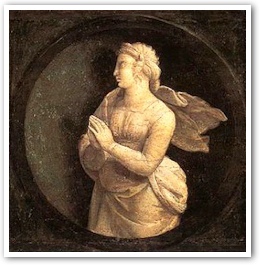The Glorified Body of Jesus
- FR. KENNETH BAKER, S.J.
After his Resurrection from the dead, Jesus manifested himself to his disciples in different ways and on different occasions.
 |
He appeared to Mary Magdalene and at first she thought he was the gardener (Jn 20:11-20). He appeared to the two disciples on the road to Emmaus. During their walk and conversation they did not recognize him, but when he broke bread for them they knew that it was the Lord (Lk 24:13-35).
There was something hauntingly mysterious about Jesus' appearances after his Resurrection. The Gospels give testimony that Jesus did indeed return to life on Easter Sunday, but to a life that was much different. It is the same Jesus, but now he appears suddenly inside the upper chamber, "the doors being shut" (Jn 20:19). We do not really know what the qualities of the resurrected body are, but from the Gospel accounts it does seem that Jesus' body possesses power over material things in a way that is beyond our experience and knowledge.
We know that two bodies cannot occupy the same space at the same time. Still, the glorified Jesus passes through walls like light through a window. He is able to converse and associate with disciples who knew him well, such as Mary Magdalene and the two men on the way to Emmaus, but he does not allow them to recognize him. This means he can let them see him but they can recognize him only if he so wills. Again, this shows that Jesus has power over his body that vastly exceeds anything we are familiar with, except perhaps in the creative imagination of science fiction.
One conclusion that follows from the Gospel accounts of the appearances of Jesus is that matter has capabilities that modern man, whether scientist or not, knows nothing about.
In order to confirm the faith of his disciples in his Resurrection, Jesus had to convince them that it was really he. All four Gospels mention the Resurrection, and each gives some details regarding the appearances (cf. Mk 28; Mk 16; Lk 24; Jn 20-21). First of all, they recognized him in his physical appearance his body was the same body, though transformed, that they had known during the preceding three years. Thomas doubted, so the Lord said to him: "Put your finger here and see my hands; and put out your hand and place it in my side; do not be faithless, but believing" (Jn 20:27). To all the assembled disciples, he said: "See my hands and my feet, that it is I myself; handle me and see; for a spirit has not flesh and bones as you see that I have" (Lk 24:39).
Jesus also showed that he was the same Person by his mannerisms the way he spoke, his tone of voice, that way he ate and drank and broke bread. By these and other signs he proved to them that it was really he and that he was now enjoying a completely new and different kind of life.
It is difficult for man to believe in the resurrection of his body, and there are many today, including some Christians, who do not believe it. Death is all around us and there is a terribly finality about it. Jesus had foretold his Resurrection, but his followers had not grasped it. Thomas would not believe it even after the other ten Apostles had seen the risen Lord. He demanded special proofs. Because of this innate difficulty for man to believe in the Resurrection, Jesus went to great lengths to establish the reality of his Resurrection for his Apostles. He showed them some aspects of his glory, but not all of it. For if he had shown the fullness of his glory, it would have been too overpowering for them and they would have been tempted to think that it as not the same Jesus they had walked with on the dusty paths of Judea and Galilee.
Thus, by his many appearances and his gentle ways, Jesus aroused and confirmed the faith of his Apostles in his Resurrection. They knew it was the same Lord now living a new, glorified life.
See the index of chapters from Fundamentals of Catholicism which have been reprinted to CERC here.
 This is Meaghen Gonzalez, Editor of CERC. I hope you appreciated this piece. We curate these articles especially for believers like you.
This is Meaghen Gonzalez, Editor of CERC. I hope you appreciated this piece. We curate these articles especially for believers like you.
Please show your appreciation by making a $3 donation. CERC is entirely reader supported.

Acknowledgement
Kenneth Baker, S.J. "The Glorified Body of Jesus." In Fundamentals of Catholicism Vol. 1 Chapter 23 (San Francisco: Ignatius Press, 1995), 72-74.
This article reprinted with permission from Father Kenneth Baker, S.J.
The Author

 Father Kenneth Baker, S.J., assumed editorship of Homiletic & Pastoral Review in April 1971 and remained in this position for almost forty years. In 1983 he published a three-volume explanation of the faith called Fundamentals of Catholicism Vol. 1, Creed and Commandments; Vol. 2, God, Trinity, Creation, Christ, Mary; and Vol. 3, Grace, the Church, the Sacraments, Eschatology
Father Kenneth Baker, S.J., assumed editorship of Homiletic & Pastoral Review in April 1971 and remained in this position for almost forty years. In 1983 he published a three-volume explanation of the faith called Fundamentals of Catholicism Vol. 1, Creed and Commandments; Vol. 2, God, Trinity, Creation, Christ, Mary; and Vol. 3, Grace, the Church, the Sacraments, Eschatology




